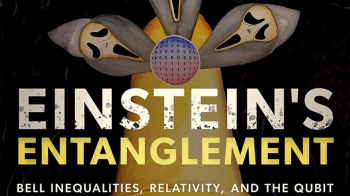
Between February 23-25, the Kavli Institute of Theoretical Physics (KITP) in Santa Barbara, California, hosted the Theory Frontier conference of the US Particle Physics Community Planning Exercise, “Snowmass 2021“. Organised by the Division of Particles and Fields of the American Physical Society (APS DPF), Snowmass aims to identify and document a scientific vision for the future of particle physics in the U.S. and abroad. The event brought together theorists from the entire spectrum of high-energy physics, fostering dialogue and revealing common threads, to sketch a decadal vision for high-energy theory in advance of the main Snowmass Community Summer Study in Seattle on 17-26 July.
It was also one of the first large in-person meetings for the US particle physics community since the start of the COVID-19 pandemic.
The conference began in earnest with Juan Maldacena’s (IAS) vision for formal theory in the coming decade. Highlighting promising directions in quantum field theory and quantum gravity, he surveyed recent developments in “bootstrap” techniques for conformal field theories, amplitudes and cosmology; implications of quantum information for understanding quantum field theories; new dualities in supersymmetric and non-supersymmetric field theories; progress on the black-hole information problem; and constraints on effective field theories from consistent coupling to quantum gravity. Following talks by Eva Silverstein (U. Stanford) on quantum gravity and cosmology and Xi Dong (UC Santa Barbara) on geometry and entanglement, David Gross (KITP) brought the morning to a close by recalling the role of string theory in the quest for unification and emphasising its renewed promise in understanding QCD.
Clay Cordova (Chicago), David Simmons-Duffin (Caltech), Shu Heng Shao (IAS) and Ibrahima Bah (Johns Hopkins) followed with a comprehensive overview of recent progress in quantum field theory. Cordova’s summary of supersymmetric field theory touched on the classification of superconformal field theories, improved understanding of maximally supersymmetric theories in diverse dimensions, and connections between supersymmetric and non-supersymmetric dynamics. Simmons-Duffin made a heroic attempt to convey the essentials of the conformal bootstrap in a 15-minute talk, while Shao surveyed generalised global symmetries and Bah detailed geometric techniques guiding the classification of superconformal field theories.
The first afternoon began with Raman Sundrum’s (Maryland) vision for particle phenomenology, in which he surveyed the pressing questions motivating physics beyond the Standard Model, some promising theoretical mechanisms for answering them, and the experimental opportunities that follow. Tim Tait (UC Irvine) followed with an overview of dark- matter models and motivation, drawing a contrast between the more top-down perspective on dark matter prevalent during the previous Snowmass process in 2013 (also hosted by KITP) and the much broader bottom-up perspective governing today’s thinking. Devin Walker (Dartmouth) and Gilly Elor (Mainz) brought the first day’s physics talks to a close with bosonic dark matter and new ideas in baryogenesis.
The final session of the first day was devoted to issues of equity and inclusion in the high-energy theory community, with DPF early-career member Julia Gonski (Columbia) making a persuasive case giving a voice to early-career physicists in the years between Snowmass processes. Connecting from Cambridge, Howard Georgi (Harvard) delivered a compelling speech on the essential value of diversity in physics, recalling Ann Nelson’s legacy and reminding the packed auditorium that “progress will not happen at all unless the good people who think that there is nothing they can do actually wake up and start doing.” This was followed by a panel discussion moderated by Devin Walker (Dartmouth) and featuring Georgi, Bah, Masha Baryakhtar (Washington), and Tien-Tien Yu (Oregon) in dialogue about their experiences.
Developments across all facets of the high-energy theory community are shaping new ways of exploring the universe from the shortest length scales to the very longest
The second and third days of the conference spanned the entire spectrum of activity within high-energy theory, consolidated around quantum information science with talks by Tom Hartman (Cornell), Raphael Bousso (Berkeley), Hank Lamm (Fermilab) and Yoni Kahn (Illinois). Marius Wiesemann (MPI), Felix Kling (DESY) and Ian Moult (Yale) discussed simulations for collider physics, and Michael Wagman (Fermilab), Huey-Wen Lin (Michigan State) and Thomas Blum (Connecticut) emphasised recent progress in lattice gauge theory. Recent developments in precision theory were covered by Bernhard Mistlberger (CTP), Emanuele Mereghetti (LANL) and Dave Soper (Oregon) and the status of scattering-amplitudes applications by Nima Arkani-Hamed (IAS), Mikhail Solon (Caltech) and Henriette Elvang (Michigan). Masha Baryakhtar (Washington), Nicholas Rodd (CERN) and Daniel Green (UC San Diego) reviewed astroparticle and cosmology theory, followed by an overview of effective field theory approaches in cosmology and gravity by Mehrdad Mirbabayi (ICTP) and Walter Goldberger (Yale); Isabel Garcia Garcia (KITP) discussed alternative approaches to effective field theories in gravitation. Recent findings in neutrino theory were covered by Alex Friedland (SLAC), Mu Chun Chen (UC Irvine) and Zahra Tabrizi (Northwestern). Bridging these themes with talks on amplitudes and collider physics, machine learning for particle theory and cosmological implications of dark sector models were talks by Lance Dixon (SLAC), Jesse Thaler (MIT) and Neal Weiner (New York). Connections with the many other “frontiers” in the Snowmass process were underlined by Laura Reina (Florida State), Lian-Tao Wang (Chicago), Pedro Machado (Fermilab), Flip Tanedo (UC Riverside), Steve Gottlieb (Indiana), and Alexey Petrov (Wayne State).
The rich and broad programme of the Snowmass Theory Conference demonstrates the vibrancy of high-energy theory at this interesting juncture for the field, following the discovery of the final missing piece of the Standard Model, the Higgs boson, in 2012. Subsequent developments across all facets of the high-energy theory community are shaping new ways of exploring the universe from the shortest length scales to the very longest. The many thematic threads and opportunities covered in the conference bode well for the final Snowmass discussions with the whole community in Seattle this summer.








